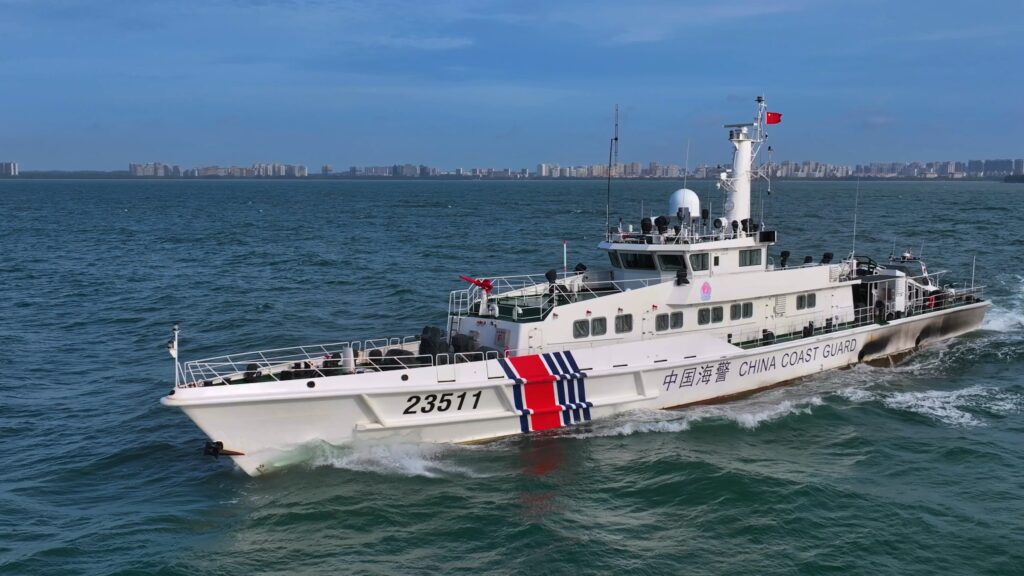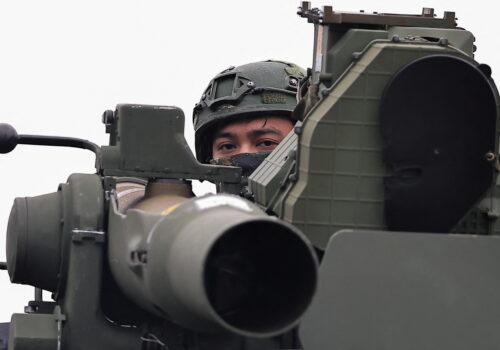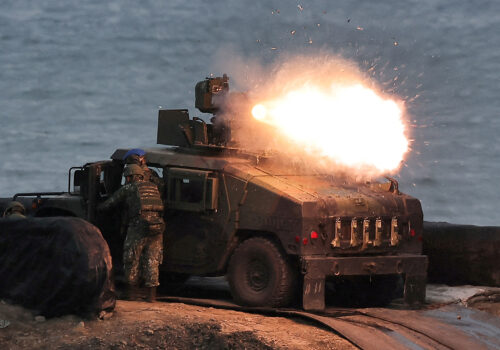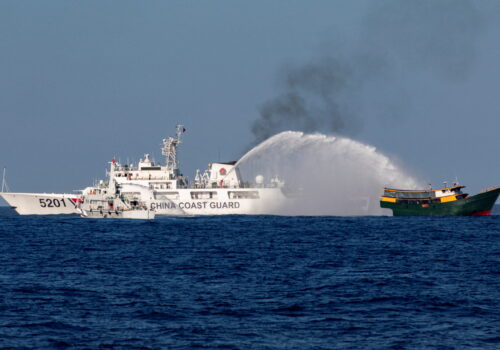On April 1, China launched a two-day military exercise against Taiwan. Taiwanese national security officials suggested it was timed to coincide with US Defense Secretary Pete Hegseth’s first trip to the Indo-Pacific since taking office. While the exercise was accompanied by the usual inflammatory and sometimes crude public messaging against Taiwan, it yielded a critical insight about China’s military operations. In describing the People’s Liberation Army (PLA) movements they observed, Taiwan’s Coast Guard disclosed that the Eastern Theater Command exercised operational control over the China Coast Guard (CCG) along with PLA military forces in theater.
This is a ground-breaking revelation. Beijing generally aims to portray the CCG as a nonmilitary actor despite its legally mandated dual role as both law enforcement and a component of China’s armed forces. This is also significant considering a previous incident in February 2024 in which Taiwan confronted the CCG when the latter was caught executing war-fighting functions against Taiwan under the guise of law enforcement activities. At the time, it was unclear whether this was merely a one-off experimental arrangement or the act of an overzealous CCG officer. It is now clear that the PLA exercises operational control over the CCG and uses the cover of law enforcement to gain military advantage over the United States, Taiwan, and their allies and partners without drawing much public attention.
China’s use of its coast guard for military purposes under the guise of law enforcement poses a threat to Taiwan that requires a strong response from Taipei, as well as the United States and its allies and partners in the region. Countering the CCG’s gray zone activities will require an active response from Taiwan and public messaging that makes clear that certain CCG law enforcement activity is a cover for military activities. It will also require a coordinated response from the US Coast Guard and Washington’s allies to provide deterrence and impose costs on China for using the CCG’s law enforcement cover to threaten Taiwan’s security.
‘White hulls’ in the gray zone
Taiwanese media reported in February 2024 that CCG vessels were identifying Taiwanese vessels and targets and providing real-time precise locations to the PLA for subsequent missile strikes while acting in a law enforcement capacity. Three CCG cutters entered the Western Pacific through the southern tip of the Miyako Strait and turned south until parallel to Taiwan’s east coast before speeding at eighteen to twenty knots eastward directly toward Taiwan. The cutters maintained radio silence, turned off their automatic identification system, and exercised emission control, an unusual precaution generally taken by military vessels, civilian vessels going through conflict zones, or vessels conducting illegal activities. The CCG cutters entered Taiwan’s twenty-four-nautical-mile contiguous zone, a buffer area internationally recognized for identification and interception of unknown vessels, and streaked past Taiwanese military and coast guard vessels sent to intercept them.
Intelligence provided to Taiwan by an undisclosed allied country indicated that these CCG vessels were validating functionalities of China’s Guo Wang, or “state network,” satellite constellation. Guo Wang designates targets for DF-21/DF-26 ballistic missiles supporting future PLA rocket force strikes against both Taiwan and US allied forces operating in the Western Pacific. The vessels only activated their automatic identification system and identified as belonging to the China Coast Guard after they passed the Taiwan Coast Guard’s TCG Nantou and came perilously close to Taiwan’s territorial waters.
Most countries’ coast guards, including those of the United States, China, and the Philippines, identify as both law enforcement and military, thus sailing in gray waters under international law. However, there is still a widely accepted norm that “white hull” vessels conducting law enforcement activities and promoting stability at sea are treated differently than “gray hull” warships safeguarding individual countries’ national interests. White hull activities near another country’s territorial waters are generally received with more goodwill and elicit less provocative reactions. China understands this and has been actively exploiting this divide since at least 2016.
The type-818 CCG vessels in the 2024 incident were 3,800-ton cutters built on People’s Liberation Army Navy (PLAN) 054A-class frigate hulls, equipped with 76 mm guns and the standard PLAN communication suite—essentially a “gray hull” in all but name. Through operational control over CCG, the PLA can use the cover of a “white hull” law enforcement facade to conduct exclusively “gray hull” military activities that would otherwise receive much stronger pushback.
How China has militarized its coast guard
Beijing reorganized the CCG in 2018, moving it from China’s State Oceanic Administration to the People’s Armed Police. The People’s Armed Police is a paramilitary that reports directly to the Central Military Commission, China’s highest military authority. The CCG’s placement under the Central Military Commission’s authority is an unusual arrangement. In the United States, for example, although the US Coast Guard is a branch of the armed forces, its chain of command runs through the Department of Homeland Security, not the Department of Defense, unless it is otherwise directed by the president or Congress during wartime. Taiwan’s Coast Guard administration also follows a similar logic.
Since the 2018 reorganization, the CCG has used its law enforcement facade to great effect in gray zone operations against Taiwan, the Philippines, and other US regional allies and partners. In the South China Sea, the CCG has been using its vessels, which include the largest coast guard cutters in the world, to “shoulder,” or attempt to ram, other countries’ coast guard vessels and force them to divert course. All the while, these vessels use their white hull cover to justify these incidents as law enforcement actions.
To protect this useful subterfuge, Beijing has been careful to disaggregate exercises conducted by the PLA and those conducted by the CCG against Taiwan since the Chinese military exercises around Taiwan that came in response to then US House Speaker Nancy Pelosi’s visit to the island in 2022. This means careful messaging from the official Weibo accounts of both the PLA’s Eastern Theater Command and the CCG. While exercises from the two entities seemed to take place within similar and sometimes overlapping timeframes, the Eastern Theater Command and CCG have different names for their respective exercises and take care to deconflict areas of operation.
Observers have long suspected operational coordination between the PLA and the CCG, but to date, only circumstantial evidence has linked the organizations. It is known that the PLA coordinates some of China’s gray zone operations through the Eastern Theater Command’s Joint Operations Command Center (JOCC). Previous concurrent CCG exercises with PLA in the Taiwan Strait have not provided sufficient direct evidence of operational coordination by observing PLAN and CCG movements alone, though international reporting sometimes characterizes the two entities’ actions as a combined exercise.
The revelation came from Taiwan’s Coast Guard administration, which stated on April 1 that the CCG, while ostensibly law enforcement, operates under the control of military theater commands. In the case of exercises against Taiwan, this would mean the Eastern Theater Command’s JOCC. Additionally, for the first time since the exercises in response to Pelosi’s visit in 2022, the CCG conducted joint operations with the PLA east of Taiwan, confirming its role in exercises for a potential joint quarantine/blockade against Taiwan.
Consequently, the April exercise indicates that the CCG is operationally controlled by PLA. And the 2024 incident provided an example of China unilaterally escalating cross-strait tension by conducting military operations with ostensibly law enforcement white hull vessels against Taiwan during peacetime, without even the facade of declaring a military exercise. These developments have far-reaching implications beyond garden-variety gray zone operations. These practices are highly provocative and require strong but measured responses from the United States and Taiwan, as well as their partners and allies in the region.
How the US and Taiwan should respond
To stop Beijing from gaining additional military advantage under the guise of law enforcement activities, Taiwan must combine a proper active response with strong public messaging. Taipei’s active responses must be commensurate with the nature of each incident—dispatching military assets to intercept and guard against the CCG’s military activities against Taiwan while leaving law enforcement issues for Taiwan’s Coast Guard. This will create significant challenges for the Taiwan Navy and Coast Guard’s existing command-and-control, but it is essential to counter China’s use of the CCG as cover to gain military advantage over Taiwan. Taiwan’s public messaging must adequately establish this. Taiwan should present the public with credible evidence, including intercepted signals intelligence, electro-optical recordings, and the exact courses and speeds of offending CCG vessels.
Meanwhile, the United States and its allies and partners must impose additional costs for the CCG’s clandestine activity. Joint patrols led by the US Coast Guard and the coast guards of other allied nations can form a credible deterrent against China’s militarization of law enforcement activities. The US Coast Guard already extensively collaborates with the Taiwan Coast Guard. A joint patrol within Taiwan’s exclusive economic zone or even within the twenty-four nautical mile contiguous zone, modeled after the US Coast Guard’s agreement with Taiwan’s diplomatic ally Palau, can impose significant costs for the CCG should it decide to engage in provocative behaviors like the February 2024 missile targeting incident. Additional support from Japan or even the Philippine Coast Guard, such as joint patrols, could lend further legitimacy to counter the militarization of the CCG. Taken together, these measures can send a strong message to Beijing and mark clear redlines against the CCG’s participation in the PLA’s gray zone activities.
Kitsch Liao is an associate director of the Atlantic Council’s Global China Hub. Previously, he worked in the US Congress, in diplomatic postings, and as a cyber intelligence analyst for the private sector.
Further reading
Tue, Mar 25, 2025
Reading between the lines of Taiwan’s new Quadrennial Defense Review
New Atlanticist By Kitsch Liao
The recently released Quadrennial Defense Review offers a window into the Taiwanese military’s issues with prioritization, operational readiness, and manpower retention.
Thu, Dec 5, 2024
How could US-Taiwan security ties change under Trump 2.0?
New Atlanticist By Kitsch Liao
The incoming administration will have significant decision-making power over how the United States would respond to a Taiwan crisis.
Tue, Oct 15, 2024
How the US and the Philippines should counter Beijing’s aggression in the South China Sea
New Atlanticist By
Washington, Manila, and their Indo-Pacific allies must work together to counter China’s maritime aggression in Philippine waters.
Image: SANSHA, CHINA - OCTOBER 14: China Coast Guard vessel conducts patrol operations on October 14, 2024 in Sansha, Hainan Province of China. Photo by Wang Jian/VCG.




